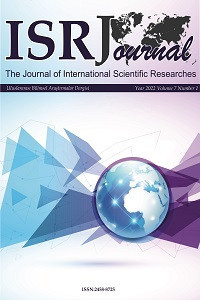E-Devlet Uygulamalarının Çevik Geliştirme Süreçlerinde Güvenli Yazılım
Çevik Yazılım Geliştirme Süreci, Güvenli Yazılım, Güvenlik Mühendisliği Süreçleri, E-Devlet Güvenliği
Secure Software Development in Agile Development Processes of E-Government Applications
Agile Software Development Process, Secure Software, Security Engineering Processes, E-Government Security,
___
- Alberts, J., & Allen, R. (2011). Risk based measurement and analysis: Application to software security. Carneige Mellon University Pittsburg: Software Enginnering Instıtute.
- Ambler, S. (2013). Retrieved from The Agile System Develpoment Lifecycle: http://www.ambysoft.com/agileLifecycle.html
- Anderson, R. (2003). What is Security Engineering? In Security Engineering. New York: Wiley.
- Baca, D., & Carlsson, B. (n.d.). Agile Development with Security Engineering Activities.
- Beznosov, K., & Kruchten, P. (n.d.). Towards Agile Security Assurance.
- Bostrom, G., & Jaana Wayrynen, M. B. (2006). Extending XP Practices to support Security Requirements Engineering (pp. 11-17). ACM SESS 06.
- Creel, R. (2007). Assuring Software Systems Security: Life Cycle Considerations for Government Acquisitions. Carnegie Mellon University , https://www.us-cert.gov/bsi/articles/best-practices/acquisition/assuring-software-systems-security---life-cycle-considerations-government-acquisitions.
- Davis, N. (2005). Secure Software Development Life Cycle Processes: A Technology Scouting Report. http://www.dtic.mil/docs/citations/ADA447047: Carnegie-Mellon Univ Pittsburgh Pa Software Engineering Inst.
- Dyba, T., & Dingsoyr, T. (n.d.). Emprical Studies of Agile Software Development: A Systematic Review. Information and Software Technology Elseiver, 883-859.
- Efe, A. (2013). COBIT-5 Framework As A Model For The Regional Development Agencies In TURKEY. INTERNATIONAL JOURNAL OF eBUSINESS AND eGOVERNMENT STUDIES, 33-43, http://dergipark.gov.tr/download/article-file/257103.
- Efe, A. (2016). Kamu Yönetiminde COBIT-5 Çerçevesinde Risk Yönetimi: Türkiye’de Kalkınma Ajansları Özelinde Bir Analiz . Uluslararası Eğitim Bilim ve Teknoloji Dergisi, 1 - 18, http://dergipark.gov.tr/uebt/issue/21610/232109.
- Efe, A. (2016). Unearthing and Enhancing Intelligence and Wisdom Within the COBIT 5 Governance of Information Model. ISACA Journal, http://www.isaca.org/Knowledge-Center/Research/Documents/COBIT-Focus-Unearthing-and-Enhancing-Intelligence-and-Wisdom-Within_nlt_Eng_0416.pdf.
- Efe, A. (2017). A Model Proposal for Organizational Prudence and Wisdom Within Governance of Business and Enterprise IT. ISACA Journal, http://www.isaca.org/Knowledge-Center/Research/Documents/COBIT-Focus-A-Model-Proposal-for-Organizational-Prudence_nlt_Eng_0317.pdf.
- Efe, A. (2017). Kamu Yönetiminde Cobit-5 Bilişim Yönetişiminin Kalkinma Ajanslari Özelinde Uygulanabilirliği. Yönetim Bilişim Sistemleri Dergisi, 1-26, http://dergipark.gov.tr/download/article-file/331323.
- Ge, X., Richard F. Paige, F. A., Chivers, H., & Brooke, P. J. (2006). Agile development of secure web applications. Proceeding ICWE '06 Proceedings of the 6th international conference on Web engineering , (pp. 305-312 ). Palo Alto, California, USA .
- Geer, D. (2010). Are Companies Actually Using Secure Development Life Cycles? Computer, Volume: 43 Issue: 6.Ghani, I., & Yasin, I. (2013). Software Security Engineering in Extreme Programming Methodology: A Sistematic Literature (pp. 215-221). Science International Volume.
- Hossein Keramati, S.-H. M. (2008). Computer Systems and Applications. Integating Software Development Security Activities with Agile Methodologies (pp. 749-754). ACS/IEEE International Conference on Computer Systems and Applications.
- Howard, H., & Lipner, S. (2006). The Security Development Lifecycle. Microsoft Press.
- J. Wayrynen, M. B. (August 15-18, 2004). Security Engineering and Extreme Programmng and Agile Methods. Calgary, Canada.
- Othmane, L., Weffers, H., Angin, P., & Bhargava, B. (2014). Extending the agile development process to develop acceptably secure software. IEEE Transactions on dependable and secure computing.
- Ouslati, H., & M.M. Rahman, L. O. (n.d.). Literature Review of the Challenges of Developing Secure Software Using the Agile Approach.
- Peeters, J. (2017). Secure Application Development. Retrieved from Agile Security Requirements Engineering: https://handouts.secappdev.org/handouts/2008/abuser%20stories.pdf
- S. Bryan, S. (2010). Security Practices for Agile Development. MSDN Magazine.
- Tondel, I. A., Jaatun, M. G., & Meland, P. H. (2008). Security Requirements for the Rest of Us: A Survey. IEEE Software.
- Wayrynen, J., & M. Boden, G. B. (2004). Security. Engineering and Extreme Programming: An Impossible Marriage? (p. 117). In Proceedings of the 4th Conference on Extreme Programming and Agile Methods.
- Wimmel, M. V., & Wisspeintner, A. (2002). Secure Systems Development Based on the Common Criteria: the palME Project. South Carolina, USA: Tenth ACM SIGSOFT Symposium.
- ISSN: 2458-8725
- Yayın Aralığı: Yılda 3 Sayı
- Başlangıç: 2016
- Yayıncı: Salih YILDIZ
Muhittin Cavusoglu, Serdar Ongan, Cihan Cobanoglu
Üstün ÖZEN, Handan ÇAM, Dilara CAN, Özge DÖNMEZ
E-Devlet Uygulamalarının Çevik Geliştirme Süreçlerinde Güvenli Yazılım
Ahmet Efe, Nisanur Mühürdaroğlu
Firmaların E-Devlet Hizmetleri Kullanımını Etkileyen Faktörler: EKAP Üzerine Bir Uygulama
Salih YILDIZ, Mehmet Hanefi TOPAL, Emel YILDIZ, Büşra TOSUNOĞLU
Türkiye'nin Avrupa Birliğine Katılımı: Olumlu ve Olumsuz Görüşler
Açıklık Üzerindeki Engeller: Teknoloji Geliştirme Bölgesi Firmaları Örneği
